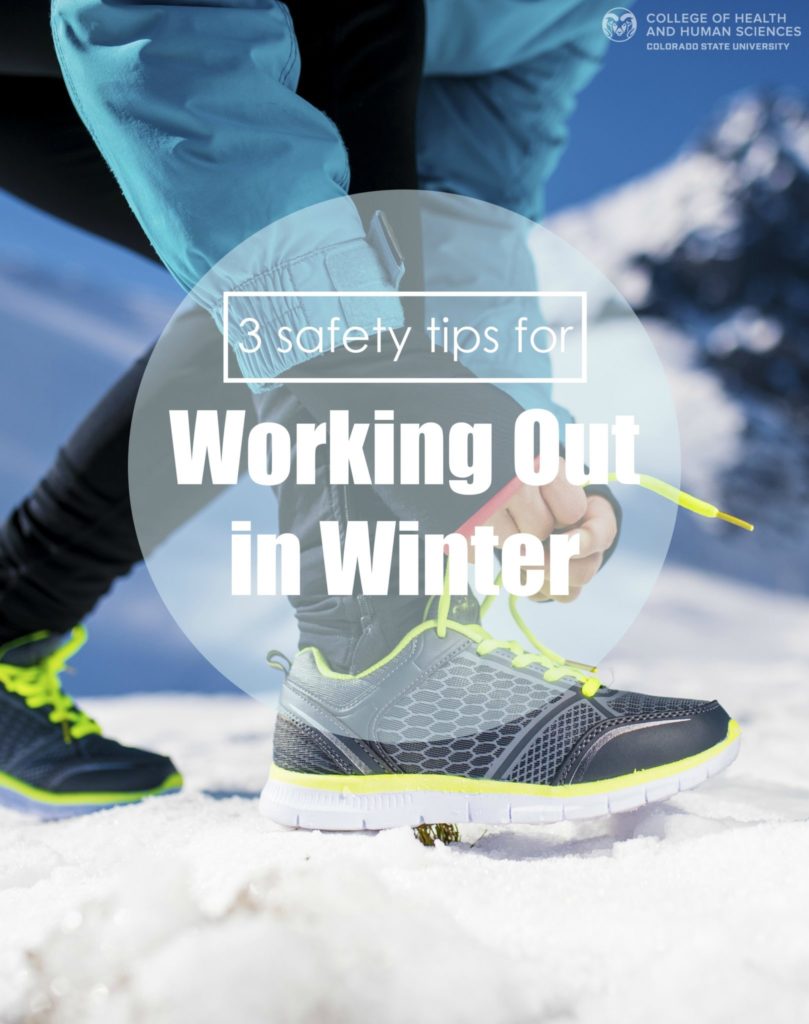The arrival of colder weather and a change in seasons might make some consider moving workouts in doors, but in Colorado you don’t have to. Between the many days of sunshine and winter recreational sports, many can keep up with year-round outdoor activity. Some forms of exercise may be more extreme and require lots of additional equipment and time to commute to venues that support the activity, like snowshoeing, skiing, snowboarding etc. Other forms of exercise, that you likely do in the summer, are more easily accomplished right outside your door, like running or biking. Here are some tips for having a safe workout for colder weather.
For both runners and bikers clothing, hydration, and traction are key for winter workouts.
Clothing
Layers make the difference in any workout, but especially in a winter workout. You don’t want to be too hot or too cold, and you want to be able to adjust easily. Key areas to cover are your head, ears, hands, and feet. This means hats, earmuffs, sunglasses, scarfs, gloves and shoes that hopefully are water proof or water repellent. Having items that can zip and unzip easily help you adjust on the go rather than having to stop to add or take off layers.
For winter workouts, it’s important to always check the weather to avoid being caught in an unexpected storm and to know how much to layer. Plus, there is a difference between 40 degrees and sunny, and 40 degrees and cloudy or windy. Many athletic apparel lines now also make summer versus winter clothing to help you select the right running tights or biking gloves. Although not traditionally thought of as clothing, another layer you should be considering in the winter is sunscreen. Sunburns are a year-round “luxury” in Colorado. Avoid the goggle burn and keep your skin safe and healthy by lathering on the SPF.
Finally, it’s important this time of year to stay visible during workouts especially for anyone working out close to the road. An early sunset and grey mornings can make you hard to see, so stay visible and use your layers to help.
Hydration
In warmer weather, we are often triggered by heat and sweat to make sure we are drinking water and staying hydrated. Some of those signals can be a little harder to read and are easily missed in the winter months. It important to maintain hydration especially at high altitude, no matter what time of year it is. You want to think about water consumption before, during, and after exercise — that means having a water bottle close at hand. Even though cold water during cold weather may not sound pleasant, it is still a must. You can always warm-up with a hot drink after the workout.
Traction
Both for tires and for shoes, traction is important in the winter when we get snow, ice and everything in between. Tires can be modified for greater traction during the winter months. Consider slightly wider tires and riding at a little less pressure than usual. This will give the tire more surface area and contact with the road when biking. Start with rear brakes over front breaks to prevent spinning out.
For shoes, you want to make sure they still have good tread, and you might consider options with more traction like trail shoes or clamps to provide greater grip if running on snow and ice. Many surfaces will still be plowed during the winter, so you can often keep to your regular routes without changing much. Still, keep an eye out for ice.
Remember to exercise with the conditions in mind. Winter does not mean you cannot workout, but it does mean you have to be a little more cautious during your workout.
Kimberly Burke is the director of the Adult Fitness Program at Colorado State University, an outreach program through the Department of Health and Exercise Science. Adult Fitness offers exercise opportunities for employees of CSU as well as community members, while providing hands-on learning experiences for health promotion students. To learn more see http://hes.chhs.colostate.edu/outreach/adultfitness/
For more health tips, visit the College of Health and Human Sciences Pinterest board.